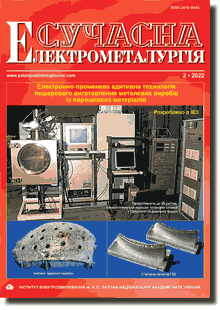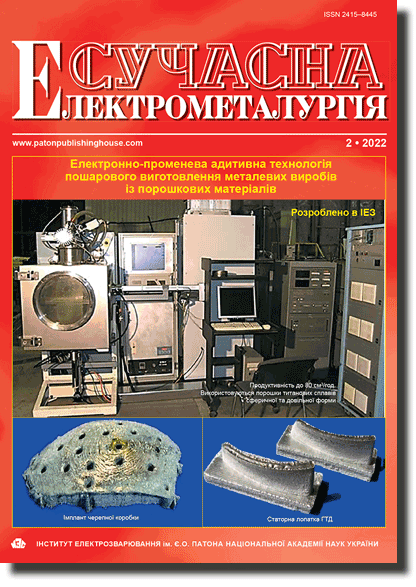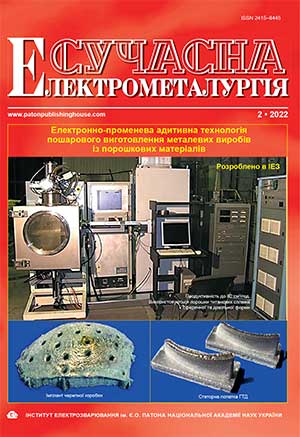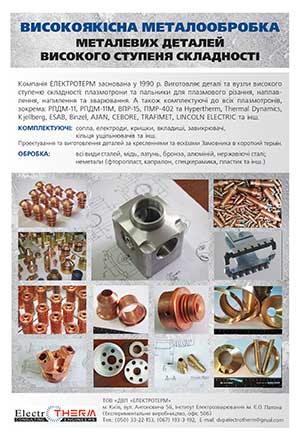| 2022 №02 (06) |
DOI of Article 10.37434/sem2022.02.07 |
2022 №02 (01) |

"Suchasna Elektrometallurgiya" (Electrometallurgy Today), 2022, #2, 50-57 pages
Features of formation of the microstructure and mechanical properties of steel 20, modified by nanoparticles, which was produced by electron beam melting
V.V. Pashinskyi, M.R. Gadzyra, S.V. Akhonin, Ya.G. Timoshenko, V.O. Berezos
E.O. Paton Electric Welding Institute of the NAS of Ukraine. 11 Kazymyr Malevych Str., Kyiv, 03150, Ukraine. E-mail: office@paton.kiev.ua
Abstract
Studied were the features of formation of microstructure and mechanical properties of steel 20, modified by nanoparticles of SiC-based complex modifier and reduced wolframite. It is found that wolframite interaction with thermally-expanded graphite leads to formation of complex Fe3W3C, W(N, C), FeC and Fe2Si carbides. Compositions based on powdered iron of PZhR-4M grade and synthesized master alloys were remelted by EBM method. Produced ingots were hot rolled at temperatures of 1000…600 °С with up to 90 % degree of deformation. After that the metal was subjected to water hardening from 870…970 °С temperatures and tempering at 500…650 °С temperatures. Yield limit values on the level of 800…1000 MPa at relative elongation of 15… 20 % were obtained. It was found that the mechanism of modifier action was revealed both in steel grain refinement and in realization of dispersion strengthening due to blocking of mobile dislocations by dispersed particles. It was experimentally confirmed that increase of the content of dispersed tungsten carbides in the test melts leads to a more obvious and stable effect of physical yield in the hardened state that may be regarded as an indicator of the presence of nanosized high-strength modifying phase. Ref. 15, Tabl. 1, Fig. 6. Key words: electron beam melting; modifying; nanoparticles; yield limit; relative elongation; rolling; hardening; tempering; dislocations; Frank‒Read source
Received 08.04.2022
References
1. Jiao, Z.B., Liu, C.T. (2017) Ultrahigh-strength steels strengthened by nanoparticles. Sci. Bulletin, 62(15), 1043-1044. https://doi.org/10.1016/j.scib.2017.07.0122. Jiao, Z.B., Luan, J.H., Miller, M.K. et al. (2017) Co-precipitation of nanoscale particle sin steels with ultra high strength for a new era. Materials Today, 20(3), 142-154. https://doi.org/10.1016/j.mattod.2016.07.002
3. Wengang Zhai, Wei Zhou, Sharon Mui Ling Nai (2022) Grain refinement and strengthening of 316L stainless steel through addition of TiC nanoparticles and selective laser melting. Mater. Sci. and Engin. A, 832, 142460. https://doi.org/10.1016/j.msea.2021.142460
4. He Zhang, Wen-Xin Wang, Fang Changandoth (2021) Microstructure manipulation and strengthening mechanisms of 40Cr steel via trace TiC nanoparticles. Ibid., 822(3), 141693. https://doi.org/10.1016/j.msea.2021.141693
5. Hao Guo, Shufeng Yang, Yanling Zhang et al. (2019) Effect of surface-modified MgO nanoparticles on intragranular ferrite nucleated on inclusions in low-alloy steel. Materials & Design, 182, 108004. https://doi.org/10.1016/j.matdes.2019.108004
6. Bingxu Wang, Yu Zhang, Feng Qiu et al. (2022) Role of trace nanoparticles in manipulating the widmanstatten structure of low carbon steel. Materials Letters, 306, 130853. https://doi.org/10.1016/j.matlet.2021.130853
7. Shiqi Zheng, Rosalía Rementeria, Wenbin Kanandoth (2021) Nanoparticle enabled high performance high modulus steels. Scripta Materialia, 201, 113954. https://doi.org/10.1016/j.scriptamat.2021.113954
8. Hanlin Peng, Ian Baker, Ling Hu, Liejun Li (2022) Superior strength-ductility synergy in a novel tailored nanoparticles-strengthened medium-entropy alloy. Ibid., 207, 11427. https://doi.org/10.1016/j.scriptamat.2021.114278
9. Jiao, Z.B., Luan, J.H., Miller, M.K. et al. (2015) Effects of Mn partitioning on nanoscale precipitation and mechanical properties of ferritic steel strengthened by NiAl nanoparticles. Acta Materialia, 84, 283-291. https://doi.org/10.1016/j.actamat.2014.10.065
10. Roohollah Jamaati, Mohammad Reza Toroghinejad, Hossein Edris (2013) Fabrication of nanoparticle strengthened IF steel via ARB process. Mater. Sci. and Engin. A, 583, 20-24. https://doi.org/10.1016/j.msea.2013.06.068
11. Mikhaylov, O.V., Pavlygo, T.M., Serdyuk, G.G., Svystun, L.I. (2004) Technology of sintered structural materials with dispersed structure. Reologiya, Structura ta Vlastyvosti Poroshkovykh ta Composytsiynykh Materialiv. Сollect., LDTU, 100-108 [in Russian].
12. Yiyuan Wang, Shun Dong, Xiutao Li et al. (2021) Synthesis, properties, and multivarious applications of SiC nanoparticles: A review. Ceramics Intern. https://doi.org/10.1016/j.ceramint.2021.12.208
13. Gadzyra, N.F., Davidchuk, N.K., Tymoshenko, Ya.G. (2015) Preparation of highly dispersed powder ligature in the (SiC-C)-WO3 system and its using for hardening of alumina ceramics. Visnyk Ukrainskogo Materializnavchogo Tovarystva, 8, 76-83 [in Russian].
14. Gadzira, M., Gnesin, G., Mythaylyk, O. et al. (1998) Solid solution of carbon in β-SiC. Materials Letters, 35, 227-282. https://doi.org/10.1016/S0167-577X(97)00263-2
15. Akhonin, S.V., Pikulin, A.N., Berezos, V.A. et al. (2019) Laboratory electron beam UE-208M installation. Sovrem. Elektrometal., 3, 15-22 https://doi.org/10.15407/sem2019.03.03
Advertising in this issue:
The cost of subscription/purchase order journals or individual articles
| Journal/Currency | Annual Set | 1 issue printed |
1 issue |
one article |
| TPWJ/USD | 384 $ | 32 $ | 26 $ | 13 $ |
| TPWJ/EUR | 348 € | 29 € | 24 € | 12 € |
| TPWJ/UAH | 7200 UAH | 600 UAH | 600 UAH | 280 UAH |
| AS/UAH | 1800 UAH | 300 UAH | 300 UAH | 150 UAH |
| AS/USD | 192 $ | 32 $ | 26 $ | 13 $ |
| AS/EUR | 180 € | 30 € | 25 € | 12 € |
| SEM/UAH | 1200 UAH | 300 UAH | 300 UAH | 150 UAH |
| SEM/USD | 128 $ | 32 $ | 26 $ | 13 $ |
| SEM/EUR | 120 € | 30 € | 25 € | 12 € |
| TDNK/UAH | 1200 UAH | 300 UAH | 300 UAH | 150 UAH |
| TDNK/USD | 128 $ | 32 $ | 26 $ | 13 $ |
| TDNK/EUR | 120 € | 30 € | 25 € | 15 € |
AS = «Automatic Welding» - 6 issues per year;
TPWJ = «PATON WELDING JOURNAL» - 12 issues per year;
SEM = «Electrometallurgy Today» - 4 issues per year;
TDNK = «Technical Diagnostics and Non-Destructive Testing» - 4 issues per year.









